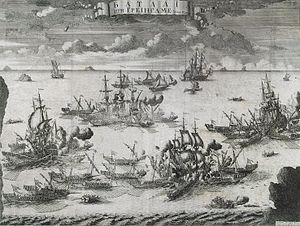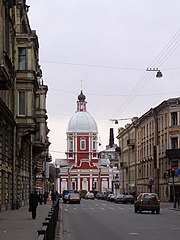| Battle of Grengam | |||||||
|---|---|---|---|---|---|---|---|
| Part of Great Northern War | |||||||
 The Battle of Grengam, July 27, 1720. A 1721 etching by Alexey Zubov. | |||||||
| |||||||
| Belligerents | |||||||
|
|
| ||||||
| Commanders and leaders | |||||||
| Vice Admiral Carl Georg Siöblad |
General Mikhail Golitsyn Admiral Matija Zmajević | ||||||
| Strength | |||||||
|
1 Ship of the line 4 frigates 3 galleys 6 smaller craft[3] over 1,000 sailors |
61 galleys 29 boats 11,000 sailors and soldiers[4] | ||||||
| Casualties and losses | |||||||
|
103 killed, 407 taken prisoner, 4 frigates captured |
Russian accounts: 43 galleys 1,100 killed[6] | ||||||
The Battle of Grengam (Russian: Гренгамское морское сражение, Swedish language: Slaget vid Ledsund, or Slaget vid Föglöfjärden .[7] ) of 1720 was the last major naval battle in the Great Northern War that took place in the Åland Islands, in the Ledsund strait between the island communities of Föglö and Lemland. The battle marked the end of Russian and Swedish offensive naval operations in Baltic waters. The Russian fleet conducted one more raid on the Swedish coast in spring 1721, whereupon the Treaty of Nystad was signed, ending the war.[8]
Location of the battle[]
The main shipping route between the ports of Stockholm in Sweden and Turku in Finland passes through the Åland Islands. It enters the Ledsund strait from south-west with Föglö on the south-east side and Lemland on the north-west.[9] An anchorage (60°0′0″N 20°18′0″E / 60°N 20.3°ECoordinates: 60°0′0″N 20°18′0″E / 60°N 20.3°E) of the shore of Flisö in Föglö is protected from the prevailing south-westerly winds by two small islands. This anchorage was previously called Granhamn, Swedish for 'Spruce harbor'. On modern maps it is marked as Rödskärs flädan after the larger of the two protecting islands.[10] The smaller island is now called Granhamns holmen or Granhamn's island. It should not be confused with the island also named Granhamn in the Stockholm archipelago.
Name[]
The word Grengam in the name of the battle is a romanization of Гренгам, which is the traditional Russian cyrillization of Gränhamn, an older spelling of Granhamn. The spelling Gränhamn was used on Hans Hansson's map of Åland from about 1650.[10] In Sweden the battle is known as the Battle of Ledsund after the Ledsund strait.[7] In Finland the name Battle of Flisö (Finnish language: Flisön meritaistelu ) is used.[3]
The battle[]
The Swedish and Russian accounts of the battle differ significantly. Both sides agree that on July 27, 1720, a group of Swedish ships under Vice Admiral Carl Georg Siöblad attacked the Russian fleet and, in a pitched battle, had their four frigates captured by Russian sailors.

Contemporary Swedish drawing of the battle, showing the Swedish ship of the line and frigates closing in on the Russian galleys.
Russian accounts[]
The Swedish squadron consisting of a 52-gun ship of the line, four frigates and nine smaller craft with a total of 156 guns and over 1,000 marines, made an attempt to attack the moving Russian fleet. General Mikhail Golitsyn managed to take an advantageous position in the narrow and shallow strait of Flisesund and ordered his ships into a semicircle formation. The Swedish ship of the line and four frigates entered the strait in pursuit of the Russian ships. Two frigates ran aground, making maneuvering for the rest of the squadron difficult. In the fierce battle that followed, all four Swedish frigates were boarded. The only ship that managed to escape was Siöblad’s flagship.[5]
Swedish accounts[]
A small Swedish naval unit sailed right into the mighty Russian fleet anchored at Granhamn. A fierce battle took place, the Swedes lost their four frigates after they had run aground[11] but the Russian losses became so heavy that the entire fleet quickly decided to withdraw from Åland, leaving 43 sunken ships and 1000 dead Russians behind.[12] The Russian losses prevented their navy from launching any further major operations until the war ended with the Treaty of Nystad the following year.
| Name | Swedish Classification | Artillery |
|---|---|---|
| Pommern | Ship of the Line |
|
| Stor Phoenix | Frigate |
|
| Vainqueur | Armed Merchantman |
|
| Kiskin | Armed Merchantman |
|
| Danska Örn | Frigate |
|
Aftermath[]

Ceremonial entrance of four captured Swedish frigates into Saint Petersburg. Etching by Alexei Zubov.
Both sides claim the outcome of the battle as their own victory. They agree only in that four Swedish frigates, the 34-gun frigate Stor Phoenix, the 30-gun Vainqueur, the 22-gun Kiskin and the 18-gun Danska Örn were captured by the Russians. No significant naval battles took place between the Russian and Swedish navies after this one until Sweden's defeat in the war was sealed by the Treaty of Nystad.
Russian accounts[]
The Swedes lost 103 killed and 407 captured. The Russians had 82 killed and 236 wounded. The Battle of Grengam demonstrated the skillful use of the rowing fleet in the skerries environment and efficient reconnaissance and selection of the combat site, as well as perfect timing for the attack from different directions. The victory at Grengam allowed the Russians to consolidate in the archipelago, which was very important for carrying out operations against Swedish shipping in the area.[5]
Swedish accounts[]
Four Swedish frigates ran aground and were captured by the Russian Navy.[11] 43 out of 61 Russian galleys, were either sunk by the Swedish force or burnt and abandoned after the battle. The Swedish Vice Admiral Carl Georg Siöblad was initially criticised after the battle, but when the scope of the Russian losses were discovered he was praised. Russia celebrated the battle as a victory, but their fleet was unable to launch effective operations until the end of the war in 1721.
Commemoration[]

Church of St. Pantaleon in St. Petersburg (1735-39)
Like the previous Battle of Gangut, the Battle of Grengam was fought on Saint Pantaleon Day. In order to commemorate the perceived victory, a timber church to this saint was built in Saint Petersburg in 1722. It was rebuilt in stone in 1735-39. Since 1914 the facade of the church has borne two marble plaques listing the ships and regiments that fought at Gangut and Grengam.
References[]
- ↑ (Swedish) Sjöhistoriska Samfundet
- ↑ p.71, Morfill, "...almost under the eyes of the English."
- ↑ 3.0 3.1 (Finnish) Flisön hylky II
- ↑ 4.0 4.1 Great Soviet Encyclopedia, Third edition, English translation, Volume 7 (1975), page 339, Granhamn. ((Russian) On-line: Гренгам)
- ↑ Tegengren, Helmer (1942) (in Swedish). Stora nordiska krigets sista sjöstrid. Åbo: Åbo Akademi. p. 30.
- ↑ 7.0 7.1 (Swedish) Nordisk familjebok, Volume 15, Column 1502, Ledsund
- ↑ p.244, Wilson, Callo
- ↑ Välkommen till Föglö (Swedish)
- ↑ 10.0 10.1 (Swedish) Inventering av fornlämningar och kulturmiljöer på Granhamnsholmen och Rödskär i Bråttö, Ålands landskapsregering, 2006
- ↑ 11.0 11.1 (Swedish) Christer Kuvaja: Karolinska krigare 1660–1721, p.257. Schildts Förlags AB 2008. ISBN 978-951-50-1823-6.
- ↑ Matts Dreijer: "The History of the Åland islands"
Sources[]
- Wilson, Alastair, Callo, Joseph F., Who's who in Naval History: From 1550 to the Present, Routledge, 2004 ISBN 0-415-30828-3
- Morfill, William Richard, A History of Russia: From the Birth of Peter the Great to Nicholas II, James Pott Publisher, London, 1902
- George Bruce. Harbottle's Dictionary of Battles. (Van Nostrand Reinhold, 1981) (ISBN 0-442-22336-6).
- (Swedish) Gunnar Unger (1923). Illustrerad svensk sjökrigshistoria, omfattande tiden 1680-1814. Stockholm: Albert Bonniers Förlag.
- (Swedish) Magnus Ullman, Rysshärjningarna på Ostkusten sommaren 1719
The original article can be found at Battle of Grengam and the edit history here.